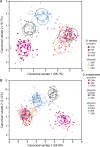Reproductive character displacement of epicuticular compounds and their contribution to mate choice in Drosophila subquinaria and Drosophila recens
- PMID: 24351014
- PMCID: PMC4278427
- DOI: 10.1111/evo.12335
Reproductive character displacement of epicuticular compounds and their contribution to mate choice in Drosophila subquinaria and Drosophila recens
Abstract
Interactions between species can alter selection on sexual displays used in mate choice within species. Here we study the epicuticular pheromones of two Drosophila species that overlap partially in geographic range and are incompletely reproductively isolated. Drosophila subquinaria shows a pattern of reproductive character displacement against Drosophila recens, and partial behavioral isolation between conspecific sympatric versus allopatric populations, whereas D. recens shows no such variation in mate choice. First, using manipulative perfuming experiments, we show that females use pheromones as signals for mate discrimination both between species and among populations of D. subquinaria. Second, we show that patterns of variation in epicuticular compounds, both across populations and between species, are consistent with those previously shown for mating probabilities: pheromone compositions differ between populations of D. subquinaria that are allopatric versus sympatric with D. recens, but are similar across populations of D. recens regardless of overlap with D. subquinaria. We also identify differences in pheromone composition among allopatric regions of D. subquinaria. In sum, our results suggest that epicuticular compounds are key signals used by females during mate recognition, and that these traits have diverged among D. subquinaria populations in response to reinforcing selection generated by the presence of D. recens.
Keywords: Mate choice; pheromones; reinforcement; sexual selection; speciation.
© 2013 The Author(s). Evolution © 2013 The Society for the Study of Evolution.
Figures



Similar articles
-
Reproductive character displacement of female mate preferences for male cuticular hydrocarbons in Drosophila subquinaria.Evolution. 2015 Oct;69(10):2625-37. doi: 10.1111/evo.12761. Epub 2015 Sep 16. Evolution. 2015. PMID: 26299584
-
Asymmetrical reinforcement and Wolbachia infection in Drosophila.PLoS Biol. 2006 Oct;4(10):e325. doi: 10.1371/journal.pbio.0040325. PLoS Biol. 2006. PMID: 17032063 Free PMC article.
-
Patterns of reproductive isolation in the Drosophila subquinaria complex: can reinforced premating isolation cascade to other species?Curr Zool. 2016 Apr;62(2):183-191. doi: 10.1093/cz/zow005. Epub 2016 Mar 3. Curr Zool. 2016. PMID: 29491905 Free PMC article.
-
Evolutionary experiments on mate recognition in the Drosophila serrata species complex.Genetica. 2002 Nov;116(2-3):239-50. Genetica. 2002. PMID: 12555782 Review.
-
Evolution of Reproductive Behavior.Genetics. 2020 Jan;214(1):49-73. doi: 10.1534/genetics.119.302263. Genetics. 2020. PMID: 31907301 Free PMC article. Review.
Cited by
-
Divergence in female damselfly sensory structures is consistent with a species recognition function but shows no evidence of reproductive character displacement.Ecol Evol. 2018 Nov 20;8(23):12101-12114. doi: 10.1002/ece3.4669. eCollection 2018 Dec. Ecol Evol. 2018. PMID: 30598803 Free PMC article.
-
Multiple sexual selection pressures drive the rapid evolution of complex morphology in a male secondary genital structure.Ecol Evol. 2015 Sep 23;5(19):4437-50. doi: 10.1002/ece3.1721. eCollection 2015 Oct. Ecol Evol. 2015. PMID: 26664690 Free PMC article.
-
Large-scale characterization of sex pheromone communication systems in Drosophila.Nat Commun. 2021 Jul 6;12(1):4165. doi: 10.1038/s41467-021-24395-z. Nat Commun. 2021. PMID: 34230464 Free PMC article.
-
The importance of intrinsic postzygotic barriers throughout the speciation process.Philos Trans R Soc Lond B Biol Sci. 2020 Aug 31;375(1806):20190533. doi: 10.1098/rstb.2019.0533. Epub 2020 Jul 13. Philos Trans R Soc Lond B Biol Sci. 2020. PMID: 32654642 Free PMC article. Review.
-
Genomic Signatures of Reinforcement.Genes (Basel). 2018 Apr 3;9(4):191. doi: 10.3390/genes9040191. Genes (Basel). 2018. PMID: 29614048 Free PMC article. Review.
References
-
- Aitchison J. The statistical analysis of compositional data. Chapman and Hall; Lond: 1986.
-
- Andersson M. Sexual selection. Princeton Univ. Press; Princeton, NJ: 1994.
-
- Bedhomme S, Chippindale AK, Prasad NG, Delcourt M, Abbott JK, Mallet MA, Rundle HD. Male-limited evolution suggests no extant intralocus sexual conflict over the sexually dimorphic cuticular hydrocarbons of Drosophila melanogaster. J Genet. 2011;90:443–452. - PubMed
-
- Blows MW, Allan RA. Levels of mate recognition within and between two Drosophila species and their hybrids. Am Nat. 1998;152:826–837. - PubMed
-
- Candolin U. The use of multiple cues in mate choice. Biol Rev. 2003;78:575–595. - PubMed
Publication types
MeSH terms
Substances
Grants and funding
LinkOut - more resources
Full Text Sources
Other Literature Sources
Molecular Biology Databases
